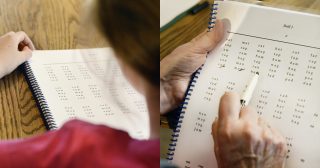13 Activities to Improve Visual Processing in LD & Dyslexic Children
February 20th, 2009Today’s post is covering 2 more areas of visual processing: Visual Closure and Visual Memory. These areas impact not only success in reading, they also impact success in math. The activities help all students whether they have a learning disability or dyslexia.
Visual Closure: The ability to identify a visual stimulus from an incomplete visual presentation.
- Put puzzles together, gradually increasing the number of pieces that are in the puzzle.
- Assemble 3-dimensional objects – models, of animals, people, cars, etc.
- Complete a partial picture of an object – draw a semi-circle and the student completes the circle.
- Complete dot-to-dot pictures.
- Complete incomplete letters or numbers.
- Read a list of words where the letters are spaced out. (Five Minutes to Better Reading Skills) is perfect for this.
Visual Memory: The ability to store and retrieve information that has been given with a visual stimulus.
- Set up a tray of objects, start with 3 and build up the amount as success increases. Let the student see the tray for 5 seconds, cover it up, then ask the student to name the objects he saw.
- Present a pattern of beads, pegs, blocks, letters, or numbers and ask the student what should come next.
- Show a pattern of beads, blocks, letters, or numbers for a set time such as 15 seconds or 30 seconds. Cover the pattern up. Have the student repeat the pattern.
- Play concentration with pictures, shapes, letters, words, playing cards. Start with three to five matching cards and gradually build up the number of pairs you use.
- Play memory games where student describe objects or pictures after they have been removed.
- Make a practice of asking questions like what did you have for breakfast today, for dinner last night.
- When you go to the playground or park, ask questions about what you did first, second, and last. Write it down, make it into a short story.
Definitions of the areas are excerpted from the Learning Difficulty/Disability Pre-Screening and Informal Comprehensive Identification Tool. It will be available soon. The book contains more information on the impact difficulties in these areas have in the classroom as well as how to determine if your student has difficulties in any of these areas.
Hope this has been helpful. Don’t forget to spread the word. If you’ve enjoyed the article, pass it on. And, if you haven’t already signed up for the FREE Teaching and Homework tips, do it now.
Bonnie Terry, M. Ed., BCET






























